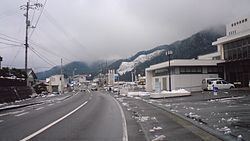Since the Meiji Restoration, what is now called Motoyama town has gone through several territorial changes. In 1889, 12 villages combined to become what was called Nishimotoyama Village, which was renamed as Motoyama Village a year later. In 1910 the village was reclassified as a "town." Also in 1889, 13 other villages neighboring Motoyama combined to become Yoshino Village. It was in 1955 when Motoyama and Yoshino villages combined, but soon after that 5 western wards were separated and were incorporated into the neighboring Tosa.
Population and Demographics
The population in Motoyama was 7,343 in 1965, but as of 2008 it has gone down to 4,110 and continues to decrease.
According to the 2005 census: the population of people 15 years old and under is 417, the population of those 65 years and over is 1,657 and the percentage of seniors in Motoyama is 38% compared to the prefectural average of 26%. There are 1,835 households with on average 2.32 people per household. The number of people per household continues to decrease as households with seniors continue to increase. It is assumed that this trend will continue for the foreseen future.
Flower Festival (Hana-matsuri) March 25 – May 6A festival which welcomes the coming of spring along with the blooming of various flowers. Cherry blossoms and
Tsutsuji (
azalea) can be seen in the central area of Motoyama, while the highlight of the festival can be seen at the nearby Kizenzan Park (帰全山公園) where over 30,000
Shakunage (
rhododendron) are displayed.
Asemi River Marathon late JulyAn annual marathon first held in 1986, where roughly 500 participants run along the Asemi river.
Yoshino River Rafting Festival middle of AugustThis raft racing festival has origins from when lumber traders shipped hinoki (
cypress) wood from Shiraga Mountain in rafts down the river. Participants can race in either traditional style raft racing or the free style division. The traditional style race involves teams with 6 participants racing on rafts made of wooden logs over 5m in length. The free style class involves participating teams bringing their own self made rafts. These teams compete over not just the visual attractiveness of the raft but also the `style` in which they raft down the river.
Town Festival middle of AugustThe annual town festival features a traditional
Taiko performance, Bon odori (Japanese folk dance), and fireworks. There is also a parade leading up to the festival where Yosakoi style dancing can be seen.
Athletic Festival early OctoberThis 50-year-old festival features teams from various businesses and professions participating in athletic competitions. Hundreds of locals participate in various athletic games in hopes of promoting the benefits of team work and healthy competition.
Autumn Culture Festival middle of NovemberHeld during the time of
harvest in Motoyama. There are also shops set up from Motoyama's sister town, Urausu. The local community center hosts stage
performances and also exhibits local art. At the closing of the festival, a
Mochi scattering ceremony is held where hundreds of people fill the assembly grounds.
Mount Kizen Park (帰全山公園, Kizen-zan kõen)In spring time the park is full of cherry blossoms and shakunage flowers (rhododendron), a sight that is famous within Kochi prefecture. In fact, the park is also called Shakunage Park. At the entrance is a statue of Kenzan Nonaka (野中 兼山), a local politician during the
Edo period.
Mount Shiraga (白髪山, Shiraga-yama)At 1470 m Shiraga is Motoyama's most prominent mountain. When ascending the mountain, one can see hinoki (cypress) trees from 150 to 200 years old by the road side.There are two approach sites where mountaineers can begin their ascent, which should take no more than 90 minutes.
Asemi River Glen (汗見川渓谷, Asemigawa keikoku)A location with thousands of years of history with beautiful flowers in the spring but is also a great place to go camping in the summer.
Akadaki Falls (赤滝)Deep inside the mountains one can see a waterfall that sews its way through the greenery and foliage.
Organic riceShiitake mushroomsReihoku beefShiso (Perilla frutescens) juiceYuzu orange juiceYuzu orange vinegarMisoGreen tea and senna teaMotoyama is renowned for its canoeing, kayaking and white water rafting.
Motoyama Town's sister city is Urausu, Hokkaidō.
On the border between Motoyama and its neighboring town to the west, Tosa, is the Sameura Dam, the largest dam in Shikoku.

